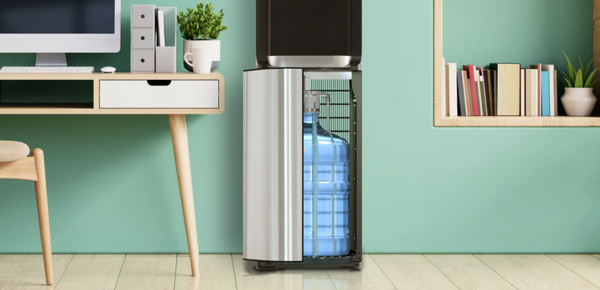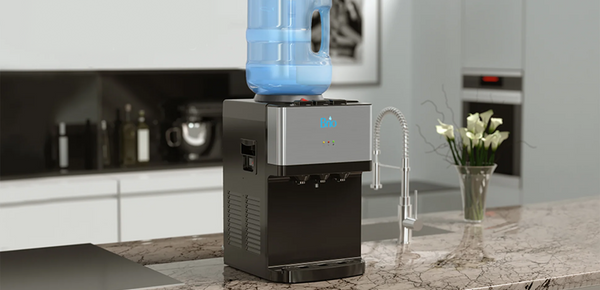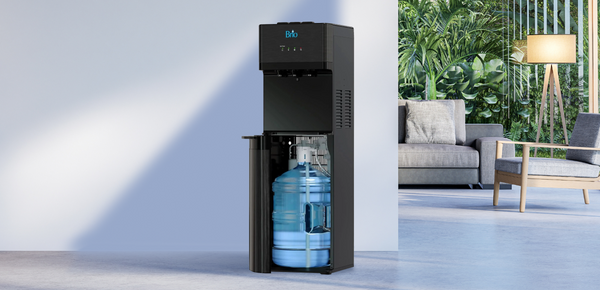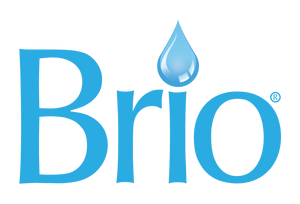Apart from the obvious, we’re here to explain the differences between bottled and bottleless water coolers. We’re giving you easy-to-digest information describing both types of coolers, along with their advantages and disadvantages, with key takeaways that will help you decide which dispenser type is best for you and your lifestyle.
What Is a Bottled Water Cooler?
As the name implies, it’s a cooler that supplies you with water directly from a bottle connected to the cooler.

Main advantages of a bottled water cooler
- It can be placed pretty much anywhere because it doesn’t require a plumbing hookup.
- It is a logical choice for use in places like home offices, dorm rooms, lobbies, and gyms.
- It’s also a great option for renters, as no permission from a landlord is required to own or use one. Perfect if you’re worried about the quality of your municipal water.
Bottled water coolers fall into two different categories: top-load and bottom-load.
Top-Load Bottled Water Coolers
Top-load coolers are the easier of the two to set up and maintain. They only require electricity to heat or chill water, not to dispense it, so they can be used even if the power is out.

- You just need to flip a 3- or 5-gallon bottle of water on top
- Let the reservoir tanks fill
- Plug the cooler in and turn on the temperature switches
- Because the bottle sits on top, you immediately know how much water you have on hand.
Brio top-load coolers conveniently come in both standalone and countertop styles.
Standalone top-load bottled coolers
Standalone units occupy space on a floor. People of shorter than average stature or people who use wheelchairs may find dispensing water from a standalone unit easier because the dispense point is lower.
One of our best-selling standalone top load bottled water coolers is the Brio 500 Series in stainless steel. Not only is it elegantly designed to suit any aesthetic, but it also features tr-temperature dispensing so you can access hot, cold and room temperature water on-demand.
It comes complete with child safety lock, an anti-rust, removable drip tray and 100% steel reservoirs to protect the water purity and temperature longevity.
Countertop bottled coolers occupy space on a kitchen counter, desk, or work bench. Available space considerations aside, countertop units generally work better for taller people as they sit higher up and, thus, are easier to dispense from.

The Brio 500 Series Countertop cooler comes with all the features of the standalone version, but in a more compact design suited to… you’ve got it… countertops.
‘Great product - love its low profile, and it’s perfect for our kitchen counter.’ - customer review.
Bottom-Load Coolers
Although a little more work to set up, bottom-load coolers make it much easier to load a bottle.
- There’s no heavy lifting and awkward flipping.
- You just connect the bottle to the cooler, slide it into the bottom compartment, and shut the door.
- Because the water bottle is hidden, bottom-load coolers tend to have a sleeker, more modern look than top-load units.

However, because bottom-load coolers need to pump the water up from the bottle and into the reservoirs, they always require power to operate, so a nearby working outlet is mandatory. And because of where the bottle is stored, they only come in standalone models.
Brio offers high-quality bottom-load coolers with the same advanced technology as its bottleless models. For instance, you can enjoy features like:
- adjustable hot and cold water
- a touch-sensitive interface
- touchless dispensing for cold water
- self-cleaning option
- child safety lock
Bottled Coolers and Filtered Water
Bottled coolers are the perfect option for many homes and offices as they can be placed just about anywhere. But their one drawback is that most do not include built-in filtration capabilities. In other words, if you want filtered water for your bottled cooler, you usually have to purchase it.

The good news is you can have a bottled cooler and filtration too. Brio offers a bottom-load unit with built-in 2-stage filtration. It includes two filters, sediment and carbon block, so you can refill your water bottle with sink water and still enjoy filtered water.
What Is a Bottleless Water Cooler?
Bottleless water coolers, also known as point-of-use (POU) coolers or plumbed-in coolers, don’t use bottles. Instead, they are connected directly to a cold-water line. Therefore, they need to be located in a place with plumbing access, like a kitchen or laundry room.

Connecting bottleless water coolers
- Connecting a bottleless cooler to a cold water line is very easy and usually requires just a wrench.
- To connect a bottleless cooler that uses reverse osmosis filtration, however, you’ll need to drill a hole in a drainpipe, which is not nearly as scary as it sounds.
Reverse osmosis filtration produces wastewater which is water containing the contaminants that have been filtered out of your drinking water. This wastewater or “brine” needs to be routed down a drain.
Like bottled coolers, bottleless coolers also come in both standalone and countertop styles, plus most are offered with tri-temperature dispensing.
The benefits of a bottleless cooler
Bottleless coolers, although pricier than bottled coolers, offer incredible hydration convenience because you can access purified, refreshing water 24/7.
- There’s no bottle that needs to be refilled or replaced
- Brio offers bottleless coolers with your choice of filtration levels: 2-, 3-, or 4- stages, including reverse osmosis and ultrafiltration
- You can eliminate plastic from your hydration life all together - say goodbye to single-use plastic bottles for good
- You can actually save money with a water filtration system
Should I buy a bottled or bottleless water cooler?
Bottled water coolers are great if you’re looking for:
- A cost-effective water-dispensing solution
- No plumbing hookup
- Multi-space capabilities beyond the kitchen, like home office, dorm room, lobby, or workshop
- Options for hot, cold and room temperature dispensing temperatures
- Zero or minimal filtration
- Portable with easy installation and maintenance
Bottleless coolers are great if you’re looking for:
- Filtered water on-demand with no water-bottle replacement or delivery service necessary
- A choice of 2-, 3-, or 4-stages of filtration, including reverse osmosis and ultrafiltration
- Options for hot, cold and room temperature dispensing temperatures
- Advanced technology options, like a total dissolved solids meter
- Reduced reliance on single-use plastics
Brio offers a wide range of premium bottled and bottleless coolers in a variety of styles, colors, and finishes that look great anywhere, and make clean, refreshing water easily accessible for everyone.




